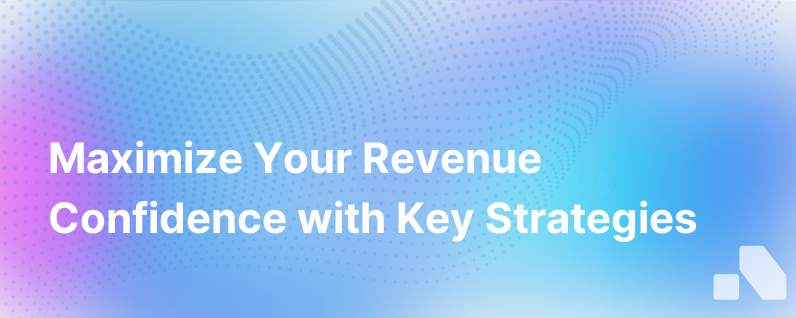Revenue Confidence Checkpoint
Published on August 12, 2023 by Sawyer Middeleer
In the ever-evolving landscape of B2B sales, one metric increasingly stands out as a signpost of sustainable success: revenue confidence. At its core, revenue confidence is the degree to which a company can predict and rely on future income streams. It is a holistic approach to assessing the health and predictability of a company's revenue generation processes.
As businesses strive to scale, they face the challenge of ensuring the integrity and reliability of their sales forecasts; essential for strategic decision-making, attracting investors, and maintaining a competitive edge. In this article, we will delve deeper into the concept of the Revenue Confidence Checkpoint, a strategic assessment designed to gauge and enhance your organization's fiscal assurance.
Understanding Revenue Confidence
Revenue confidence is not merely about whether your company will hit its quarterly or annual targets. It's a multi-dimensional construct that encompasses:
- Predictability: Can you forecast revenue with a high degree of accuracy?
- Repeatability: Are your sales processes robust and consistent?
- Growth: Is your revenue stream increasing over time?
- Margin: Are you maintaining profitability as you scale?
To achieve revenue confidence, companies must cultivate an ecosystem where marketing, sales, and customer success work symbiotically. Every customer interaction, from the awareness stage to post-sale support, should reinforce trust and endorsement of your value proposition.
The Revenue Confidence Checkpoint
Deploying a Revenue Confidence Checkpoint involves a comprehensive audit of your revenue cycle to identify strengths, weaknesses, and opportunities for improvement. This checkpoint allows your team to:
-
Assess Sales Process Maturity: Consider the level of formalization and documentation in your sales endeavors. A mature process is not about complexity or rigidity but consistency and clarity. It means having a well-defined sales methodology tailored to your market and buyer personas.
-
Measure Forecasting Accuracy: Examine historical sales data to assess the predictive accuracy of revenue forecasts. Accurate forecasting relies on quantitative data and qualitative insights, drawing from a well-maintained CRM, market trends, and buyer behavior.
-
Evaluate Pipeline Quality: Scrutinize your sales pipeline health by reviewing lead scoring, deal progression rates, and the ratio of early-stage to late-stage opportunities. A healthy pipeline is marked by movement and balance, not just volume.
-
Examine Customer Health: Assess the longevity and expansion potential within your existing customer base. Understanding customer satisfaction through Net Promoter Scores (NPS) and churn rates speaks to your solution's real-world value and the effectiveness of your success initiatives.
-
Analyze Talent and Training: Evaluate if your sales personnel are equipped with the knowledge and skills needed for success. Continuous learning and development are key, as well as ensuring alignment with evolving buyer needs.
-
Review Technology Stack Utilization: Your CRM and sales automation tools are only as effective as how they're used. Ensure your technology stack is integrated, adopted by the team, and providing actionable insights.
-
Implement Strategic Account Planning: Embrace a structured approach for target account selling, especially when dealing with complex, high-value deals. This involves mapping out key stakeholders, understanding their pain points, and customizing engagement strategies.
-
Conduct Competitor Analysis: Stay aware of competitive forces. A sound understanding of your competitors’ moves allows you to anticipate market shifts and align your strategies accordingly.
-
Monitor Market Dynamics: Be attuned to economic indicators and industry-specific trends that can impact buyer behavior and your market position. This external view complements internal data for a 360-degree perspective.
-
Solicit Customer Feedback: Engage with your customers systematically to gather feedback on your offerings and their experiences. This feedback serves as a barometer for customer sentiment and guides product development and service enhancement.
Organizations that conduct Revenue Confidence Checkpoints can take corrective action proactively, avoiding surprises at the end of the fiscal period. Moreover, the insights gleaned from these checkpoints can guide strategic initiatives and investment decisions that fuel growth.
Leveraging AI to Enhance Revenue Confidence
As the pressure for predictability and growth intensifies, the use of artificial intelligence (AI) in revenue management has become a game-changer. AI platforms like Aomni offer real-time, data-driven insights that profoundly impact the accuracy of sales forecasts and business strategies.
Utilizing AI technology enables companies to:
- Automate Data Collection and Analysis: Minimize manual tasks in compiling and evaluating sales data, ensuring timely and accurate insights.
- Analyze Buyer Intent: Leverage predictive analytics to understand buyer behavior and intent signals, tailoring engagement accordingly.
- Optimize Pricing Strategies: AI models can analyze historical data to optimize pricing, maximizing revenue potential while remaining competitive.
- Personalize Customer Journeys: AI can help customize sales and marketing content at scale, reflecting individual buyer preferences and enhancing conversion rates.
Adopting AI-driven tools leads to a more refined understanding of your sales ecosystem, contributing significantly to the solidity of revenue confidence.
Conclusion
To thrive in a competitive B2B marketplace, revenue confidence is no longer a nice-to-have – it's a necessity. By conducting regular Revenue Confidence Checkpoints, you can ensure stability and prepare for sustainable growth. Keep in mind, enhancing revenue confidence is a continuous process that adapts as your company evolves.
With the integration of AI solutions like Aomni, this task becomes more manageable and impactful, providing your team with the actionable competitive insights and customized sales content needed to sell more strategically – all with minimal effort required.